699 Search Results for communication book
May 5, 2015
by Carole Zangari -
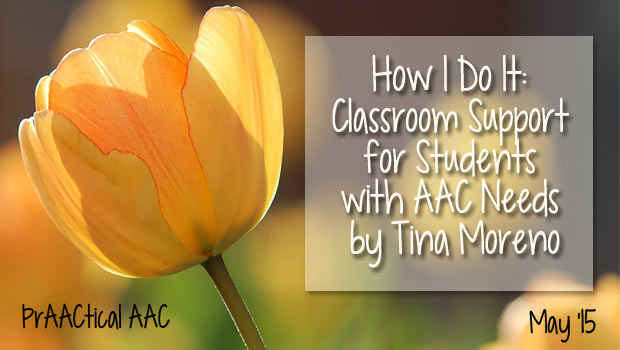
We are fortunate to have a return visit from Tina Moreno, who brings her experiences both as an SLP and also as a mom of a teenager who has used AAC for most of his life. In this post, Tina shares some of the strategies that she has used to support AAC students in their classrooms. If you are a school-based SLP, don’t miss Tina’s classroom observation form for gathering data on how AAC is being used in various activities and lessons. GIVE THEM FIVE As an SLP in the school setting, helping teachers support students in the classroom can be a big challenge. While we can see students making progress in our therapy sessions, it can be difficult to get the same results in the classroom. An important role of the SLP is to collaborate with teachers to help students generalize these skills in conversation with their peers and other... [Read More...]
April 30, 2015
by Carole Zangari -
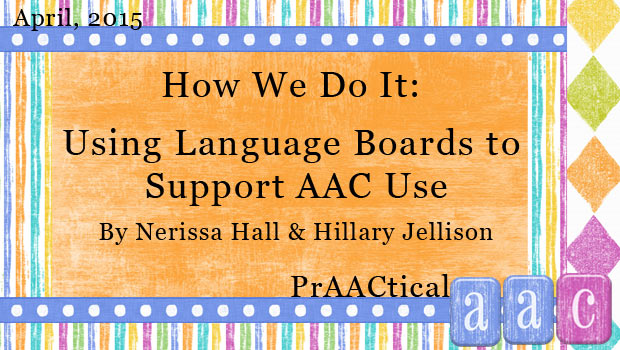
Many of you have reached out to say how much you’ve appreciated the prAACtical suggestions provided by Nerissa Hall and Hillary Jellison, New England-based SLPs and owners of Commūnicāre, LLC. We’re excited to have them back, especially because they are talking about something near and dear to our hearts: Implement a core vocabulary approach in their AAC therapy. In this post, they give us a peek into the ‘why’ and ‘how’ of making and using communication boards that are rich in core words. In their typically generous fashion, they also share templates for the boards that they make. How We Do It: Using Language Boards to Support AAC Use There are a number of different strategies one can use to support an individual’s use of augmentative and alternative communication (AAC). We know that aided language stimulation, augmented input, and AAC modeling are important and effective ways of supporting AAC use. By using... [Read More...]
April 27, 2015
by Carole Zangari -
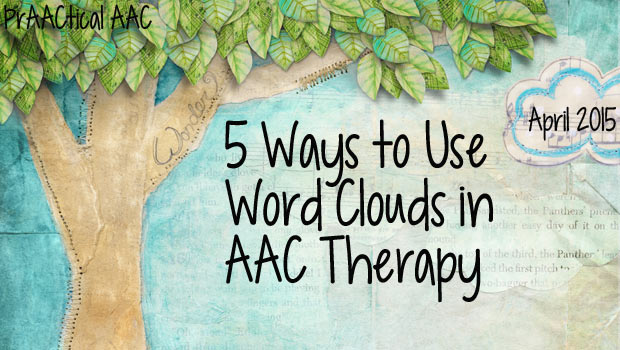
Like many of you, I enjoy using fun websites in AAC therapy sessions. Word clouds are popular therapy tools, both because of their versatility and because they are fun and easy to make. Word clouds are images composed of words on a given topic, where the frequency of use of a word determines its size in the word cloud image. There are lots of websites and apps for this, and most are free. If you are looking for a way to build literacy into your language therapy activities, this may be an option worth exploring. Here are some ideas for prAACtical things to do. Build word knowledge: Use the word cloud to define new words, provide examples, and given synonyms. Once created, you can print these out for a word notebook or display on a vocabulary word wall. You can also keep a digital copy for a vocabulary notebook that... [Read More...]
April 23, 2015
by Carole Zangari -
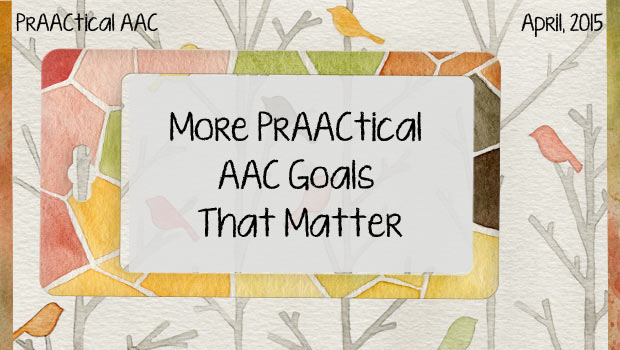
While we may play a variety of roles, a commonality among those of us on teams serving individuals with AAC needs is that we often struggle with developing goals that are meaningful. Let’s work together to develop a list of potential goals that we can reflect on as we work with our clients and their families on a plan for becoming more competent communicators. There are two sections in this post: Qualifiers (for information applying to all goals) and Goal Areas (for actual goals). This is not meant to be a comprehensive list but rather a starting point for a collaborative document. Please join the effort by adding goals in the comment area below or reaching out using our contact form. SECTION 1: QUALIFIERS Each goal can be prefaced with a description of the communicator’s AAC system or the elements of that system can be named. Terms used in this document... [Read More...]
April 21, 2015
by Carole Zangari -
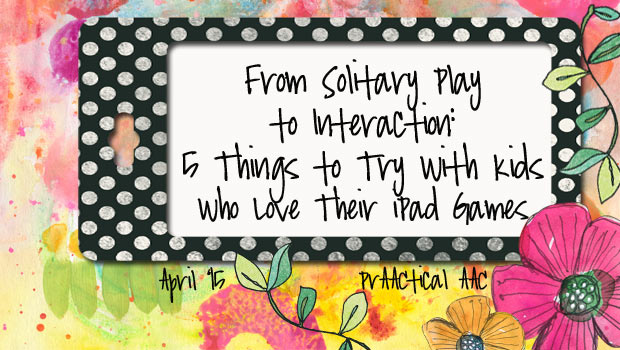
“But my kid wants to use the app on his own terms, not with ME!” Ever faced this conundrum? There are so many wonderful apps that are terrific for building interaction and language skills, but some of our prAACtical friends don’t want us to interact with them during iPad play**. Today, we’re thinking about strategies to use when kids would rather engage in solitary play as opposed to welcoming us as interaction partners in their iPad games. How can we help them increase their tolerance for interaction when playing on the iPad? Here are a few things to try. Make expectations clear with visual supports. It’s hard to cooperate when you don’t have an understanding of what’s supposed to happen. When kids are used to playing games, reading books, or watching videos on their own, they sometimes resist our participation out of the fear that they won’t get to do... [Read More...]
April 16, 2015
by Carole Zangari -
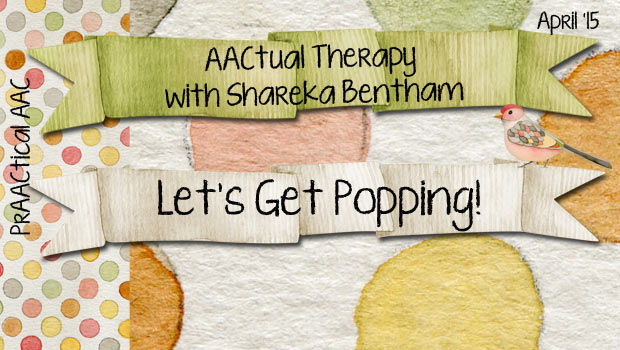
We are headed to Barbados with this post, to hear how SLP Shareka Bentham and her prAACtical friends are making popcorn and building language skills. You can see Shareka’s earlier posts here. I love the ease and versatility of this activity which could be a fun way for AAC learners to practice core vocabulary with a manual communication board/book, SGD, or PODD book. :::::::::::::::::::::::::::::::::::::::::::::::::::: I revisited this activity this week and thought that it would be a great one to share. It’s fun, functional and filling! What more do you need? Making popcorn together is not only one of the best group activities I’ve done, it’s also one of the most fun, and interactive AAC activities I’ve done. It’s a chance to learn and use new vocabulary, take turns using the AAC device and to do some requesting and describing. Initially, when I worked on this activity I only used a... [Read More...]
April 13, 2015
by Carole Zangari -

Core Words for the Month (2013 List): big, busy, do, drink, feel, he, in, make, out, some, tell, who By definition, core words are useful in any situation, with any topic and any communication partner. They are the perfect words for Earth Day because they are words that they we re-use and recycle. Even though it is a very minor holiday (at least in the US), most schools do a lot of thematic work around the topic, both because it ties in so beautifully with science education, but also because all kids seem to have a connection with and curiosity about the natural world. Before we knew better, SLPs would spend lots of time programming specific vocabulary into the learner’s AAC device. (I’m guilty as charged and can still remember trying to find symbols for things like trash compactor and pollution.) For learners who have good command of core vocabulary, we... [Read More...]
April 8, 2015
by Carole Zangari -
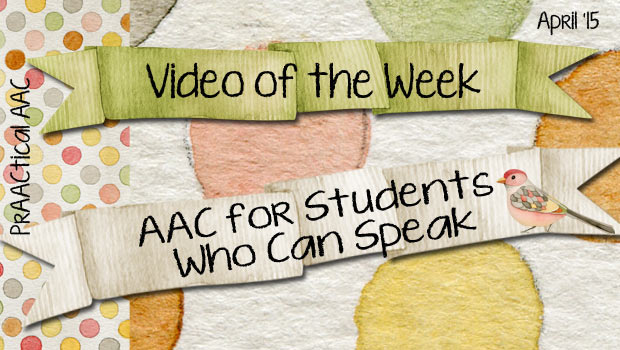
“But my student can speak. Why would we use AAC?” We often get this question from our fellow SLPs, particularly those who work with students who have autism. From the question alone, it seems like AAC is not needed, and would be a step backward for this particular student. But what happens when we dig a little deeper? The last time this question was posed to me, it was about Marcella, an 8 year old with ASD. As the conversation progressed, we learned more about Marcella’s communication profile. Independently, she uses 2-3 word sentences to ask for things she wants (e.g., “Want that popsicle.” “More Dora”) and single words to protest (“No!”). With prompting Marcella uses 1-2 words for greeting (e.g., “Hi Tony”), labelling (e.g., “Dora book”), answer questions, (e.g., “here,” “sunny”) and a few other social purposes. So, what’s the problem? For starters, Marcella is capable of more. In... [Read More...]
March 10, 2015
by Carole Zangari -
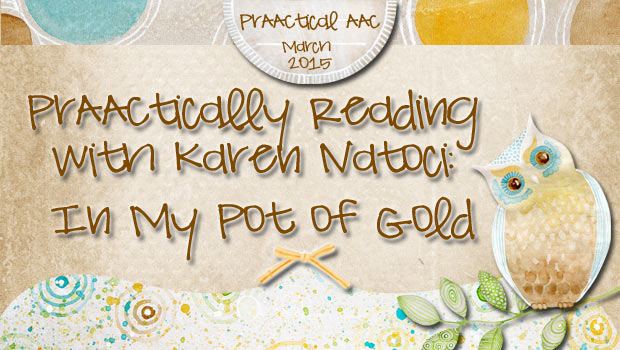
It’s green where we live, but even our friends who’ve been battling snow and ice for far too long (!) have been seeing bits of color…IF you count the rainbows and gold-filled pots in their therapy rooms, offices, and classrooms. St. Patrick’s Day can be a fun, playful holiday to celebrate, and there are plenty of thematic materials around to build language and literacy skills. For some learners, acquiring holiday-related vocabulary. like shamrock and leprachaun, makes sense. But for most of the AAC learners with whom we work, the priorities are elsewhere. That’s one reason that I’m delighted to share Karen Natoci’s PrAACtically Reading for March. As always, Karen is incredibly generous in sharing both information and materials (such as her lesson plan and PowerPoint story). What I love most about her post, though, is that it honors the excitement and traditions of the holiday while keeping focused on the goal of building core... [Read More...]
February 19, 2015
by Carole Zangari -
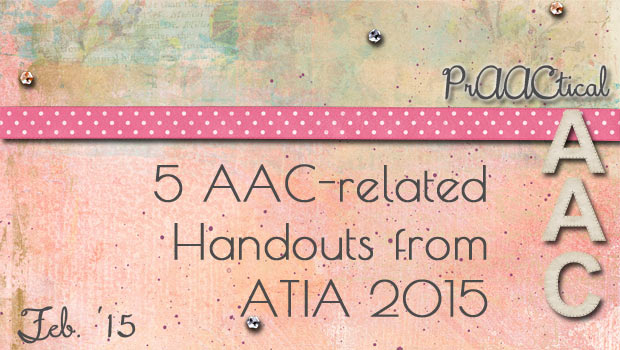
The 2015 ATIA conferences was one of the strongest in recent memory, with lots of AAC presentations to choose from. As you can see, I had a blast! There was AAC in every direction, from the Town Hall Meetings, App Smackdowns, expanded poster sessions, traditional sessions, and, of course, the exhibit hall. If professional development in AAC is a priority for you, be sure to put the 2016 conference (in Orlando) on your radar for February 2-6, 2016. In the meantime, here are some of the handouts to whet your appetite. Lori Wise and Marlene Sotelo’s terrific talk on using iPads to build social engagement with people who have ASD along with their app lists here and here was one of my favorite presentations of the conference. [Note: Their handouts are hosted on the ATIA conference site and may only be available for a limited time. Grab them while you can!] Gretchen... [Read More...]









